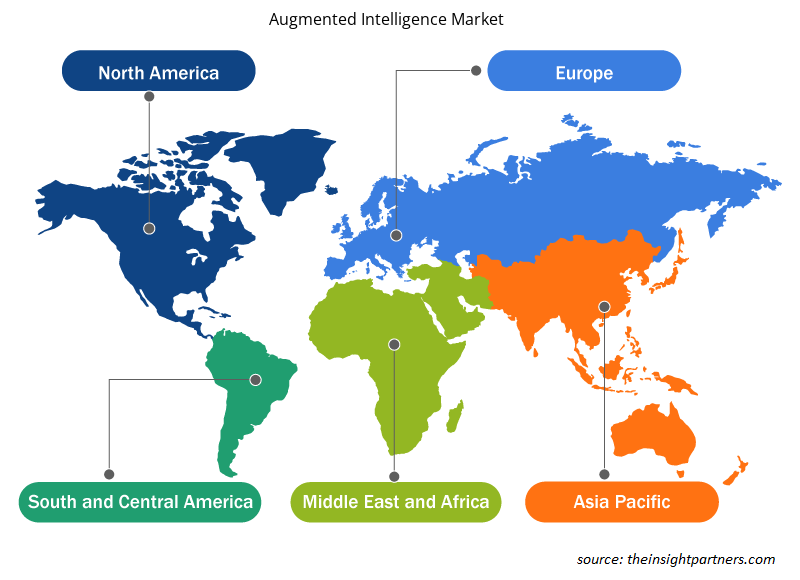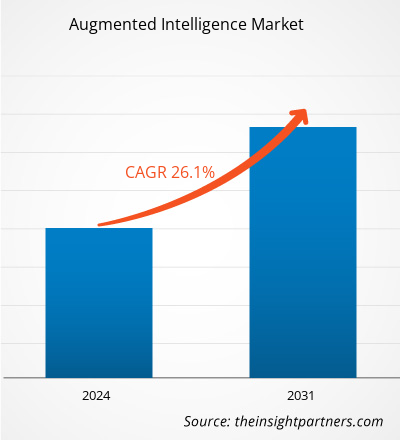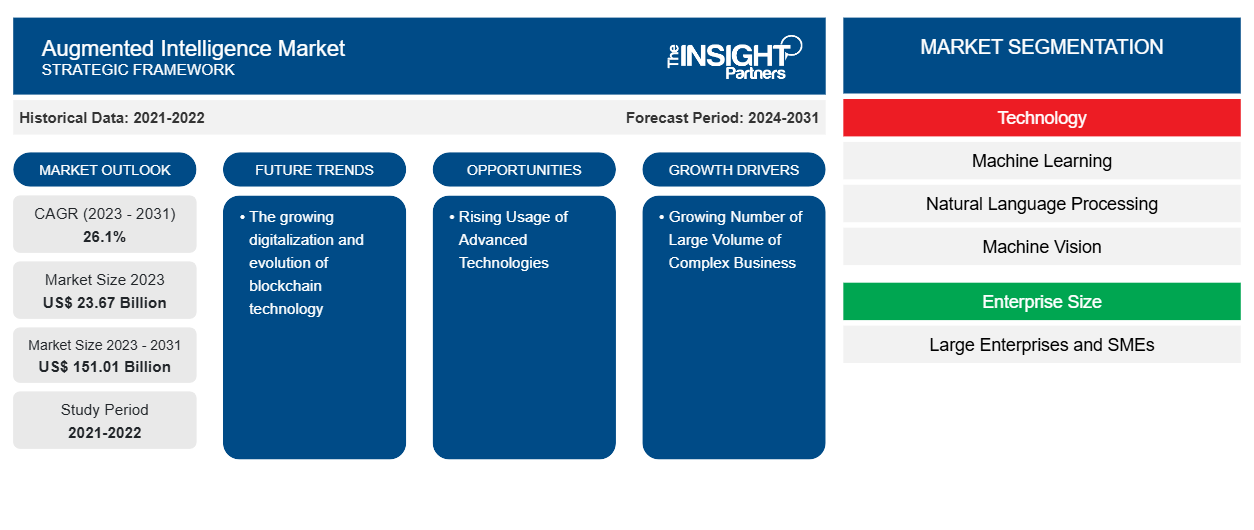Le marché de l'intelligence augmentée devrait atteindre 151,01 milliards de dollars d'ici 2031, contre 23,67 milliards de dollars en 2023. Le marché devrait enregistrer un TCAC de 26,1 % en 2023-2031. La numérisation croissante et l'évolution de la technologie blockchain devraient rester une tendance clé du marché de l'intelligence augmentée.CAGR of 26.1% in 2023–2031. The growing digitalization and evolution of blockchain technology are likely to remain a key augmented intelligence market trend.
Analyse du marché de l'intelligence augmentée
Le marché de l'intelligence augmentée connaît une croissance rapide en raison du nombre croissant de volumes importants de données commerciales complexes et de l'expansion des secteurs BFSI, IT & Telecom, Retail et e-commerce. Le marché est en constante expansion, porté par l'adoption croissante de l'intelligence augmentée par les PME. De plus, l'utilisation croissante de technologies avancées et l'adoption croissante de solutions basées sur le cloud par les entreprises offrent des opportunités lucratives de croissance du marché.
Aperçu du marché de l'intelligence augmentée
L'intelligence augmentée est un type d'intelligence artificielle qui se concentre sur les capacités d'assistance de l'IA. En outre, l'intelligence augmentée est créée pour aider les organisations à prendre des décisions plus précises basées sur les données dans les affaires et la vie quotidienne. En outre, l'intelligence augmentée est utilisée par les entreprises pour améliorer les performances de leurs employés et aide l'organisation à comprendre les domaines d'amélioration des employés qui stimulent le marché. En outre, l'intelligence augmentée est la technique la plus efficace pour utiliser et hiérarchiser une grande collection de données de sécurité en fournissant des analyses prédictives aux entreprises.
Personnalisez ce rapport en fonction de vos besoins
Vous bénéficierez d'une personnalisation gratuite de n'importe quel rapport, y compris de certaines parties de ce rapport, d'une analyse au niveau des pays, d'un pack de données Excel, ainsi que de superbes offres et réductions pour les start-ups et les universités.
-
Obtenez les principales tendances clés du marché de ce rapport.Cet échantillon GRATUIT comprendra une analyse de données, allant des tendances du marché aux estimations et prévisions.
Moteurs et opportunités du marché de l'intelligence augmentée
Le nombre croissant de volumes importants de données commerciales complexes stimule le marché
Les technologies d’intelligence augmentée, telles que l’apprentissage automatique et le traitement du langage naturel, deviennent de plus en plus importantes pour l’analyse des données. L’intelligence augmentée permet d’analyser des sources de données organisées, semi-structurées et non structurées stockées au sein des entreprises. La variété et le volume élevé de données créées devraient augmenter considérablement dans les années à venir, en raison de l’expansion des industries et de l’évolution des technologies numériques dans les opérations des entreprises. Cela accroît la demande de solutions d’intelligence augmentée parmi les entreprises pour gérer efficacement et efficacement leur grand volume de données. Cependant, le volume croissant de données complexes devrait alimenter le marché de l’intelligence augmentée au cours de la période prévue.
L’utilisation croissante des technologies avancées – une opportunité sur le marché de l’intelligence augmentée
L'utilisation croissante de technologies avancées telles que l'intelligence artificielle, l'apprentissage automatique et les technologies de traitement du langage naturel crée des opportunités de croissance du marché au cours de la période de prévision. De nombreux secteurs, tels que l'informatique et les télécommunications, la vente au détail et le commerce électronique, les BFSI, les soins de santé et d'autres, génèrent de vastes volumes de données et nécessitent des technologies avancées pour analyser ces données en temps réel, ce qui augmente la demande de solutions d'intelligence augmentée. Les industries adoptent de nouvelles technologies telles que l'intelligence artificielle, l'apprentissage automatique et le traitement du langage naturel pour analyser de vastes données en prenant des décisions efficaces en temps réel. Ces outils ont simplifié le processus d'extraction d'informations à partir des données, ce qui augmente leur adoption et crée des opportunités sur le marché.BFSI, healthcare, and others, are generating vast volumes of data and require advanced technologies for analyzing this data in real-time, which increases the demand for augmented intelligence solutions. Industries are adopting new technologies such as artificial intelligence, machine learning, and natural language processing for analyzing vast data by making effective decisions in real time. These tools have simplified the process of extracting insights from data, which increases its adoption and creates opportunities in the market.
Analyse de segmentation du rapport sur le marché de l'intelligence augmentée
Les segments clés qui ont contribué à l’élaboration de l’analyse du marché de l’intelligence augmentée sont la technologie, la taille de l’entreprise et l’utilisateur final.
- En fonction de la technologie, le marché de l'intelligence augmentée est divisé en apprentissage automatique, traitement du langage naturel, vision artificielle, informatique contextuelle et autres. Le segment de l'apprentissage automatique détenait une part de marché plus importante en 2023.
- En termes de taille d'entreprise, le marché est segmenté en grandes entreprises et en PME. Le segment des PME détenait une part de marché plus importante en 2023.
- En termes d'utilisateur final, le marché est catégorisé comme suit : informatique et télécommunications, vente au détail et commerce électronique, BFSI, soins de santé et autres. Le segment BFSI détenait une part de marché plus importante en 2023.
Analyse des parts de marché de l'intelligence augmentée par zone géographique
La portée géographique du rapport sur le marché de l’intelligence augmentée est principalement divisée en cinq régions : Amérique du Nord, Asie-Pacifique, Europe, Moyen-Orient et Afrique, et Amérique du Sud/Amérique du Sud et centrale.
En termes de chiffre d'affaires, l'Amérique du Nord représente la plus grande part de marché de l'intelligence augmentée, en raison des progrès technologiques et de la présence d'acteurs clés, notamment IBM Corporation, Microsoft Corporation, TIBCO Software Inc., Salesforce.com, Inc. et MicroStrategy Incorporated. Ces acteurs investissent massivement dans l'adoption de technologies avancées telles que l'IA, le ML et le NLP et s'engagent en permanence dans le développement de ces technologies en ajoutant des fonctionnalités supplémentaires. La demande croissante d'intelligence augmentée basée sur le cloud dans des secteurs tels que l'informatique et les télécommunications , le BFSI, la vente au détail et le commerce électronique, la santé et d'autres devrait stimuler le marché en Amérique du Nord.
Aperçu régional du marché de l'intelligence augmentée
Les tendances et facteurs régionaux influençant le marché de l’intelligence augmentée tout au long de la période de prévision ont été expliqués en détail par les analystes d’Insight Partners. Cette section traite également des segments et de la géographie du marché de l’intelligence augmentée en Amérique du Nord, en Europe, en Asie-Pacifique, au Moyen-Orient et en Afrique, ainsi qu’en Amérique du Sud et en Amérique centrale.

- Obtenez les données régionales spécifiques au marché de l'intelligence augmentée
Portée du rapport sur le marché de l'intelligence augmentée
| Attribut de rapport | Détails |
|---|---|
| Taille du marché en 2023 | 23,67 milliards de dollars américains |
| Taille du marché d'ici 2031 | 151,01 milliards de dollars américains |
| Taux de croissance annuel composé mondial (2023-2031) | 26,1% |
| Données historiques | 2021-2022 |
| Période de prévision | 2024-2031 |
| Segments couverts |
Par technologie
|
| Régions et pays couverts |
Amérique du Nord
|
| Leaders du marché et profils d'entreprises clés |
|
Densité des acteurs du marché de l'intelligence augmentée : comprendre son impact sur la dynamique des entreprises
Le marché de l'intelligence augmentée connaît une croissance rapide, tirée par la demande croissante des utilisateurs finaux en raison de facteurs tels que l'évolution des préférences des consommateurs, les avancées technologiques et une plus grande sensibilisation aux avantages du produit. À mesure que la demande augmente, les entreprises élargissent leurs offres, innovent pour répondre aux besoins des consommateurs et capitalisent sur les tendances émergentes, ce qui alimente davantage la croissance du marché.
La densité des acteurs du marché fait référence à la répartition des entreprises ou des sociétés opérant sur un marché ou un secteur particulier. Elle indique le nombre de concurrents (acteurs du marché) présents sur un marché donné par rapport à sa taille ou à sa valeur marchande totale.
Les principales entreprises opérant sur le marché de l'intelligence augmentée sont :
- Société IBM
- Microsoft Corporation
- SAP SE
- TIBCO Software Inc.
- Sisense Inc.
- Salesforce.com, Inc.
Avis de non-responsabilité : les sociétés répertoriées ci-dessus ne sont pas classées dans un ordre particulier.

- Obtenez un aperçu des principaux acteurs du marché de l'intelligence augmentée
Actualités et développements récents du marché de l'intelligence augmentée
Le marché de l'intelligence augmentée est évalué en collectant des données qualitatives et quantitatives issues de recherches primaires et secondaires, qui comprennent d'importantes publications d'entreprises, des données d'associations et des bases de données. Voici une liste des évolutions du marché de l'intelligence augmentée et des stratégies :
- En septembre 2023, Oracle Corp a présenté aujourd'hui de nouvelles fonctionnalités basées sur l'IA dans Oracle Analytics Cloud. Les nouvelles fonctionnalités d'IA en libre-service, notamment les assistants d'IA génératifs et les analyses augmentées, aident les organisations à améliorer l'impact des données sur la prise de décision. (Source : Oracle Corp, communiqué de presse, 2023)
Rapport sur le marché de l'intelligence augmentée : couverture et livrables
Le rapport « Taille et prévisions du marché de l’intelligence augmentée (2021-2031) » fournit une analyse détaillée du marché couvrant les domaines ci-dessous :
- Taille du marché et prévisions aux niveaux mondial, régional et national pour tous les segments de marché clés couverts par le périmètre
- Dynamique du marché, comme les facteurs moteurs, les contraintes et les opportunités clés
- Principales tendances futures
- Analyse détaillée des cinq forces de PEST/Porter et SWOT
- Analyse du marché mondial et régional couvrant les principales tendances du marché, les principaux acteurs, les réglementations et les développements récents du marché
- Analyse du paysage industriel et de la concurrence couvrant la concentration du marché, l'analyse de la carte thermique, les principaux acteurs et les développements récents
- Profils d'entreprise détaillés
- Analyse historique (2 ans), année de base, prévision (7 ans) avec TCAC
- Analyse PEST et SWOT
- Taille du marché Valeur / Volume - Mondial, Régional, Pays
- Industrie et paysage concurrentiel
- Ensemble de données Excel
Rapports récents
Témoignages
Raison d'acheter
- Prise de décision éclairée
- Compréhension de la dynamique du marché
- Analyse concurrentielle
- Connaissances clients
- Prévisions de marché
- Atténuation des risques
- Planification stratégique
- Justification des investissements
- Identification des marchés émergents
- Amélioration des stratégies marketing
- Amélioration de l'efficacité opérationnelle
- Alignement sur les tendances réglementaires























 Obtenez un échantillon gratuit pour - Marché de l'intelligence augmentée
Obtenez un échantillon gratuit pour - Marché de l'intelligence augmentée